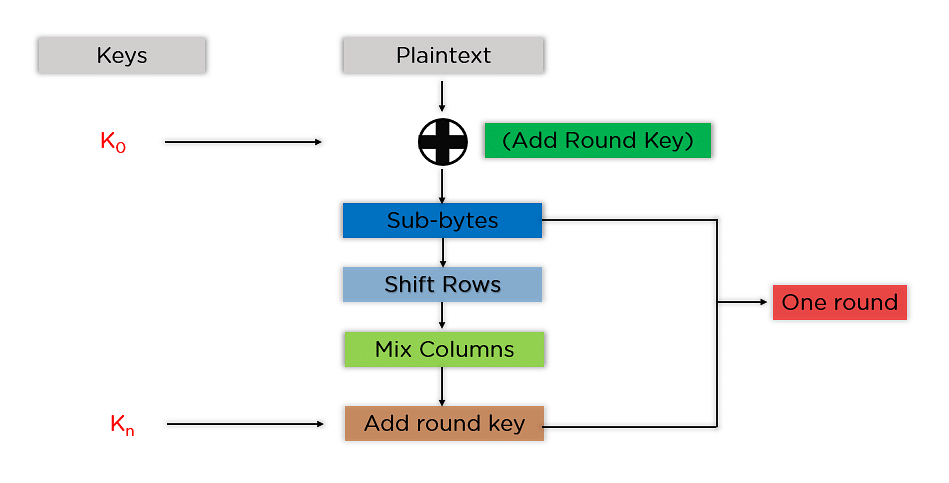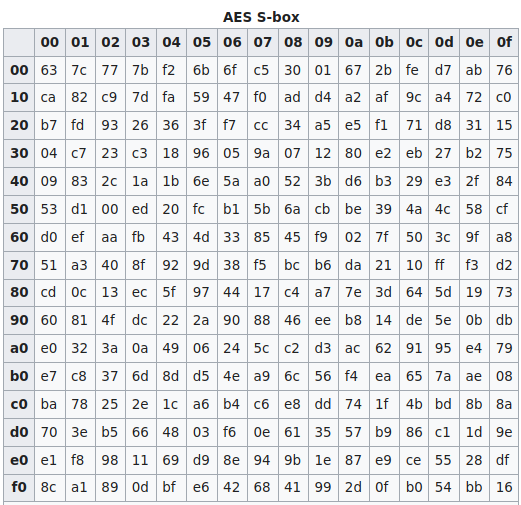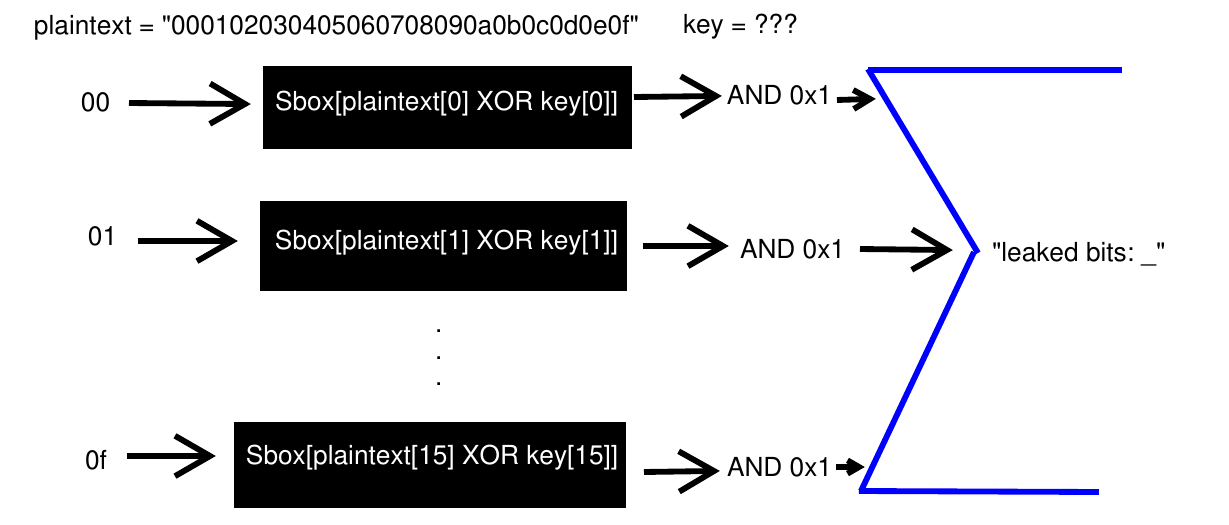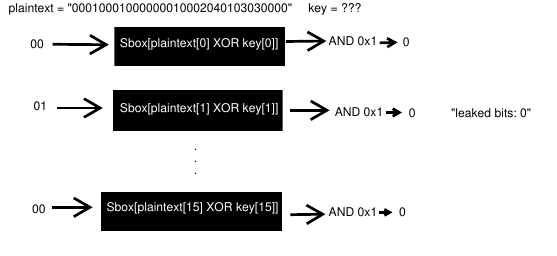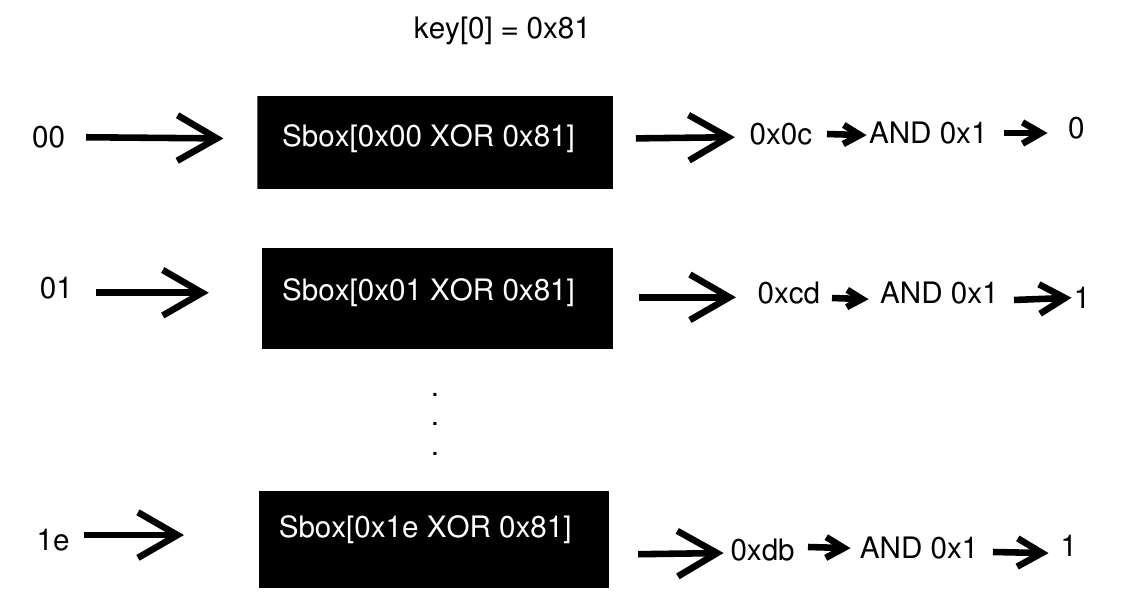Description
This encryption algorithm leaks a "bit" of data every time it does a computation. Use this to figure out the encryption key.
Additional details will be available after launching your challenge instance.
Advanced Encryption Standard (AES) is a symmetric-key block cipher used in VPNs, drive encryption, and government information protection. It is the most used encryption cipher used to date, and the versatility of its base leads to different varieties according to specific needs.
Because of its properties, this algorithm easily and quickly allows data to be encrypted and decrypted at will when a key is known. AES is a worldwide algorithm that works great, when it is not improperly configured. Several attacks are known for insecure AES, including side channel attacks (which we will be discussing later on).
Let's say Alice wants to securely send a simple 16 byte message to Bob using AES.
Alice decides to create a 16 byte key that will encrypt the message she sends to Bob. She settles on the following:
Key: "My precious key!"
Plaintext: "Are belong to us"
Alice first converts the key and the plaintext to hex:
Key: 4d792070726563696f7573206b657921
Plaintext: 4172652062656c6f6e6720746f207573
She then begins by XORing the plaintext and the key.
Ex. First byte: 0x4d XOR 0x41 = 0x0c
Second byte: 0x79 XOR 0x72 = 0x0b
Key XOR Plaintext = 0c0b455010000f060112535404450c52
Next, Alice takes each byte in the XORed result and matches it with a substitution box (S-box). Because the first byte of the XORed value is 0x0c, Alice indexes the 13th value in the S-box and substitutes it for 0x0c.
Luckily, the AES S-box is a standard lookup table originating from the Rijndael S-box.
The left column indexes with first half byte and the top row indexes using the last half byte of the input.
Ex. "0c" would be substituted for "fe".
Sub-bytes = fe2b6e53ca63766f7cc9ed20f26efe00
Although there are subsequent steps involved during the encryption process, this challenge focuses specifically on the XOR and S-box lookup in AES.
The function "leaky_aes_secret" in encrypt.py demonstrates where AES is used:
def leaky_aes_secret(data_byte, key_byte):
out = Sbox[data_byte ^ key_byte]
leak_buf.append(out & 0x01)
return out
The second line appears to be the combination of both AES steps previously defined. Additionally, the line after will leak the last bit of every substituted byte and later find the sum of the bits.
Per our example, the least significant bits of Sub-bytes would be: 0101010101100000
The sum (6) would subsequently be leaked with the line: leakage result: 6
The challenge essentially asks one question: When we are given the sum of least significant bits after providing a plaintext, is it possible to find the encryption key?
We are dealing with a side channel attack. The least significant bit of each byte is calculated and the total is leaked to the user.
Example
Let's assume the AES encryption algorithm outputs the ciphertext: "f1e03f01bba75256cd5c0d84be1bb2f2"
The least significant bit of each byte is as follows:
| Byte | LSB | Byte | LSB | |
|---|---|---|---|---|
| f1 | 1 | cd | 1 | |
| e0 | 0 | 5c | 0 | |
| 3f | 1 | 0d | 1 | |
| 01 | 1 | 84 | 0 | |
| bb | 1 | be | 0 | |
| a7 | 1 | 1b | 1 | |
| 52 | 0 | b2 | 0 | |
| 56 | 0 | f2 | 0 |
Therefore, the output would be the sum of the LSBs: leakage result: 7
How do we find the key from the result?
We must first control the leak to find the key. To do this, we must be able to correspond individual bytes to bit leakage. By providing a payload that returns 0 bits of leakage, we can move on to the next step of manipulating individual bytes.
def testbyte(bits, zero_payload): #tests payload bytes to decrease bit leakage
for i in range(0xff): #returns before completion
prepend = ''.join([x for x in zero_payload]) #increases each byte
payload = "{:02x}".format(i) + "00"*(16 - len(zero_payload) - 1)
print(prepend + payload)
result = int(sendinput(prepend + payload)) #receives the bit leakage
print("Bits: {}".format(result))
if result < bits:
return payload[0:2] #return incremented byte
elif results > bits: #LSB was already 0
return "00"
zero_payload = [] #becomes a list of payload bytes that output 0 leakage bits
for i in range(0x10): #for each byte
result = testbyte(bits, zero_payload) #lowers bit leakage if it can
zero_payload.append(result) #appends the returned byte
print(zero_payload)
if result != "00":
bits -= 1 #for each byte that once had LSBBecause I am using payload "00000000000000000000000000000000", I receive leakage result: 8.
For the first byte of the payload, increment value until it returns a bit leakage value lower than 8. If the bit count becomes higher, the byte "00" already returns LSB 0.
Repeat for each byte while prepending the bytes from the previous result to craft a "zero payload".
Thus, when we submit the "zero payload", the bit leakage will always be 0.
Now, we solve!
Choose one payload byte to increment. Record the bit leakage and the incremented payload byte. Repeat for a certain amount of times (more details later).
zero_payload = ['00', '01', '00', '01', '00', '00', '00', '01', '00', '02', '04', '01', '03', '03', '00', '00']
payload = zero_payload.copy()
data_byte = []
leak = []
position = 0 #first byte will be incremented
size = 30 #amount of increments/recordings
for i in range(size):
payload[position] = "{:02x}".format(int(zero_payload[position], 16) + i) #increment
data_byte.append(int(payload[position], 16)) #record the byte
result = int(sendinput(''.join(payload))) #get the result (1 or 0)
leak.append(result) #record resultThe bit leakage recorded will either be a 1 or a 0 (because the other 15 bytes return an LSB of 0).
What does this mean?
By curating a list of returned LSBs, it is possible to brute force the key byte by byte.
As the payload byte increments, XORing with the static key changes its value, returning different Sbox numbers. Therefore, the list of leaked Sbox LSBs matches the Sbox LSBs of a given key byte XORed with the incremented payload byte.
for key in range(0xff): #tests all possible bytes
testleak = [0] * size
for pos in range(size):
testleak[pos] = Sbox[data_byte[pos] ^ key] & 0x1 #gets LSB of possible Sbox match
if leak == testleak: #leak list defined previously
print("MATCH: 0x{:02x}".format(key))
final = key
breakWe have successfully brute forced the first byte of the AES key. Now repeat 15 more times and we've got the encryption key!
For the python solution code, see "power.py".
Overall, this was a fun challenge and a fantastic introduction to side-channel attacks. After several hours of scripting, the key is produced in 90 seconds.
Author's Note
Use the variable `SILENT=1` with `python3 power.py` to witness the beauty of the password oracle.
